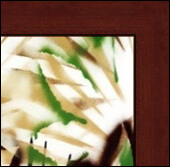What goes around a painting is almost as important as the painting itself, and since frames today are available in thousands of styles the choices are practically endless.
But there are three important things to think about when framing any work of art:
1. Does the frame match the style of the painting, and not detract from it?
2. Will the frame look appropriate with the decor of the room it will be hanging in?
3. Is it even necessary to use a traditional frame?
Let’s talk about matching the painting’s style first.
Since the frame will always be viewed right there at the same time as the work itself, it will have a huge influence on how people see your painting. That being the case, it’s important to pick a frame that is less eye-catching than your art.
At the same time, you’ll also want to avoid frames that are too similar to your painting, especially in color and value. Having a moderate amount of contrast (by using a dark frame with a predominantly light painting, for example) is often helpful not only because it gives a baseline point of reference for the colors within your art, but because it also clearly separates your art from everything else in the room.
Any colors in the frame should be carefully selected to emphasize or complement colors in the painting itself. Be careful of picking a frame with a close color that “almost” matches something in your painting. . . it’s often better to use a complementary color so you don’t have to find that perfect hue.
When in doubt choose understatement rather than overstatement, in both color and contrast.

Portraits and landscapes (which are more traditional) can be paired with more traditional looking frames. In this case, having some gilt and scrollwork won’t seem out of place. Ornate frames lend an air of importance, so you’ll most often see them used with portraits of important people.
Some landscapes don’t have enough detail in them to balance out a very decorative frame. Very still, empty landscapes—or surreal ones—might do better with a more modern frame.
Next, it’s important to think about the space that your painting will be displayed in.
If you’re selling the work, then you might never know—but if you’re presenting a series in a gallery or are responsible for its permanent location, you don’t want the frame to look out of place.
In a gallery, for example, less is more. Gallery shows are about the art itself, so a richly embellished frame will almost always just detract from the artwork.
In a home, consider the decor already on the walls. A good frame doesn’t stand out so much that it puts all other objects to shame. Rooms with darker walls or with lots of trim may work well with an ornate frame. Really, any decor that is more traditional or Victorian will accept a more ornate frame quite well.
And finally, when is it unnecessary to have a frame at all?
Personally, I think the only paintings which should always have frames are portraits.

Gallery wraps have the canvas going all the way around to the back of the stretcher bars, leaving clean canvas edges. (No staples showing, in other words.)
For artists who don’t have the money to spend framing each painting, this makes it very easy to finish up a piece without going broke. Simply paint the canvas as though the front image is wrapping around onto the edges themselves, or use a solid color all the way around. With the addition of a hanging wire, the painting is complete.
You can buy gallery wrap canvases at stores like Dick Blick, Utrecht, and Aaron Brothers; or, if you’re so inclined, you can stretch the canvas yourself.
And although I said this already, it bears repeating: the best frame (or even no frame at all) is simply the one that lets your art take center stage.
This post may contain affiliate links.

